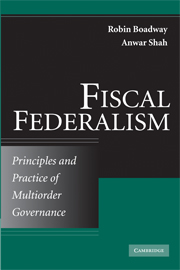PART TWO - REVENUE SHARING AND FISCAL TRANSFERS
Published online by Cambridge University Press: 05 June 2012
Summary
Matching revenue means with expenditure needs as closely as possible for various orders of government is a desirable goal to strengthen accountable governance. In practice, such a goal is not realized because of greater difficulties in decentralizing taxing powers than expenditure responsibilities and the desire to leave the federal government with some room for the use of spending power to influence subnational policies to achieve national objectives. Several chapters in this section address the use of these important fiscal tools in securing a common economic union.
Mismatch between the revenue means and expenditure needs or vertical fiscal gap, usually for lower orders of government, is a common occurrence in federal countries for reasons discussed earlier. Such gaps can be mitigated through a transfer of a predetermined share of federal revenues either on a tax-by-tax basis or from a specific or general pool to subnational governments. Chapter 8 discusses the pros and cons of revenue sharing and assesses the usefulness of alternate revenue-sharing mechanisms.
Chapter 9 details the instruments of intergovernmental finance available to exercise the federal spending power. It highlights the incentives, accountability implications, and potential impacts of various instruments and associated designs. The chapter discusses the use of performance-oriented transfers to achieve results-based accountability while preserving autonomy and flexibility of decentralized decision making. The chapter then presents the economic rationale of federal-state-local fiscal transfers and discusses grant design issues to advance equity and efficiency objectives of such transfers.
- Type
- Chapter
- Information
- Fiscal FederalismPrinciples and Practice of Multiorder Governance, pp. 291 - 292Publisher: Cambridge University PressPrint publication year: 2009



